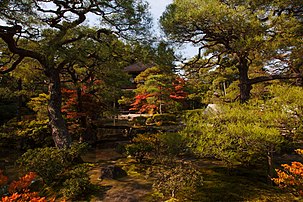Srebrny Pawilon
 Ginshadan, Kōgetsudai, Ginkaku-ji | |
| Państwo | |
|---|---|
| Miejscowość | |
| Typ budynku | |
| Ukończenie budowy | 1482 |
| Strona internetowa | |
Srebrny Pawilon (jap. 銀閣寺 Ginkaku-ji) (właśc. Świątynia Srebrnego Pawilonu) lub Jishō-ji (jap. 慈照寺) – świątynia[a] buddyjska w dzielnicy Sakyō-ku w Kioto w Japonii. Jest ośrodkiem szkoły rinzai buddyzmu zen[1]. W 1994 została wpisana na listę światowego dziedzictwa UNESCO jako część Zespołu zabytkowego dawnego Kioto, Uji i Ōtsu[2].
Historia
Ginkaku-ji została zbudowana w 1482 przez sioguna Yoshimasę Ashikagę (1435–1490), wzorującego się na Kinkaku-ji, Złotym Pawilonie, zbudowanym przez jego dziadka. Zamierzał pokryć Ginkaku-ji srebrem, ale w 1467 z powodu wojny wstrzymano budowę i tego planu nigdy nie zrealizowano.
Podobnie jak Kinkaku-ji, Ginkaku-ji została zbudowana, aby służyć jako spokojne i odosobnione miejsce wypoczynku dla sioguna. Yoshimasa Ashikaga niewiele interesował się polityką, przedkładając nad nią sztukę i kulturę. Przyczynił się do odrodzenia kultury dworskiej, zwanej „Higashiyama bunka”, którą kultywował w Ginkaku-ji, kontemplując spokój i piękno ogrodów, podczas gdy wojna Ōnin obróciła Kioto w ruinę.
W 1485 Yoshimasa został mnichem buddyjskim zen, a po jego śmierci w 1490 Ginkaku-ji przekształcono w świątynię o nazwie Jishō-ji. Do dzisiaj zachowały się tylko dwa budynki: Srebrny Pawilon i pawilon Tōgu-dō (東求堂) (skarb narodowy) z 1485, w którym znajduje się jedno z najstarszych pomieszczeń (chashitsu) do ceremonii picia herbaty.
Obok świątyni rozciąga się ogród pełen mchu, ze stawami, wysepkami i mostkami, małymi strumieniami i licznymi, różnymi roślinami oraz tradycyjny ogród japoński suchego krajobrazu, zaprojektowany prawdopodobnie przez Sōamiego (1455–1525): Ginshadan („Morze Srebrnego Piasku”), którego częścią jest kopiec piasku o nazwie Kōgetsudai („Platforma do oglądania księżyca”), kojarzony także z górą Fudżi[1][3].
Galeria
Zobacz też
- Karesansui (ogród suchego krajobrazu)
Uwagi
- ↑ W piśmiennictwie polskim dot. Japonii przyjęto słowo „chram” jako tłumaczenie jinja, a słowo „świątynia” – buddyjskiej tera (o-tera). Podobnie jest w innych językach, w tym w języku angielskim: jinja → „shrine”, tera → „temple”.
Przypisy
Media użyte na tej stronie
Autor: Maximilian Dörrbecker (Chumwa), Licencja: CC BY-SA 3.0
Location map of Japan
Equirectangular projection.
Geographic limits to locate objects in the main map with the main islands:
- N: 45°51'37" N (45.86°N)
- S: 30°01'13" N (30.02°N)
- W: 128°14'24" E (128.24°E)
- E: 149°16'13" E (149.27°E)
Geographic limits to locate objects in the side map with the Ryukyu Islands:
- N: 39°32'25" N (39.54°N)
- S: 23°42'36" N (23.71°N)
- W: 110°25'49" E (110.43°E)
- E: 131°26'25" E (131.44°E)
Flag of the United Nations Educational, Scientific and Cultural Organization (UNESCO)
Autor: Jmhullot, Licencja: CC BY 3.0
The Silver Pavilion lost in the trees around Kinkyo-chi pond
Autor: Basile Morin, Licencja: CC BY-SA 4.0
Dry-sand Zen garden made of long beige stripes, front view with perspective impression, flowers and trees in the background, a sunny day with blue sky, at Higashiyama Jisho-ji enduring Zen Buddhist temple, Ginkaku-ji ("Temple of the Silver Pavilion"), Sakyo Ward, Kyoto, Kyoto Prefecture, Japan.
Autor: Jmhullot, Licencja: CC BY 3.0
Ginkakuji, the "Temple of the Silver Pavillion" is the popular name for the temple formerly known as Jishōji. This temple has its origin in the elegant villa known as the Higashiyama-dono, the "Palace of the Eastern Mountains" established by the eighth Muromachi shōgun, Ashikaga Yoshimasa (1436-1490).The "silver pavilion" of Ginkaju-ji temple is the sedate, two-story Kannon Hall (designated as a National Treasure) on the far side of the raised sand gardens dominating the central court. Yoshimasa, a votary of both zen as well as the True Pure Land teachings, practiced meditation in the shoin-style room comprising of the lower story, which he named "Shinkuden" (Hall of the Emptied Mind). The upper story, which he named "Chōonkaku" (Sound-ofWaves Pavilion), holds a gilt image of Kannon, Goddess of Mercy.
Autor: Jmhullot, Licencja: CC BY 3.0
In addition to the Kannon Hall-that is, the building known as the Silver Pavilion- the other of the two structures surviving from the original construction of the villa is the Tōgudo (East Seeking Hall; designated as a National Treasure). It originally housed an image of the Buddha, and thus it symbolized Yoshimasa's affinity for the True Pure Land religion, while the fact that he is building a Zen-style garden around speaks of the breadth of Yoshimasa's religious world.
Autor: Jmhullot, Licencja: CC BY 3.0
Seen against the silvery sand garden (ginsadan) raked with patterns of waves, and the distinctive mound of white sand known as the Kō getsudai, the pavilion, though never once covered with silver, strikes an exquisite image.
Autor: Jmhullot, Licencja: CC BY 3.0
The sand garden of Ginkaku-ji has become particularly well known; and the carefully formed pile of sand which is said to symbolize Mount Fuji is an essential element in the garden.
















